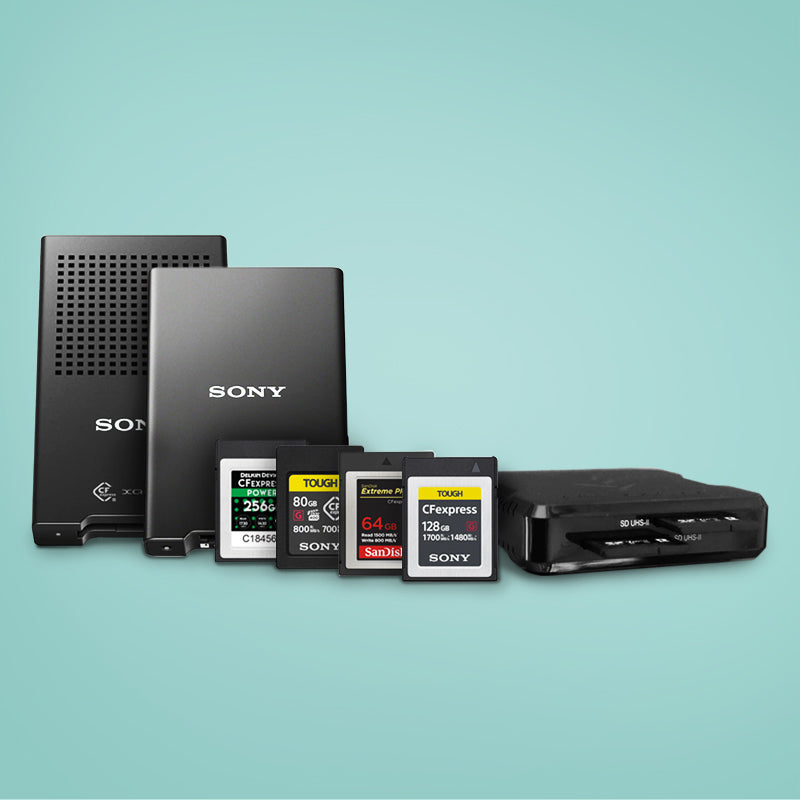Any photographer in the know has no doubt heard the news. Yes! Another new format of memory card has arrived—the CFexpress card. If you’ve been a photographer for 15+ years, your studio space likely contains the likes of Compact Flash, Memory Stick, XD, MMC, Mini SD, Micro SD, SD, SDHC, SDXC and SD UHS-II memory cards (Who else is crossing their fingers for yet another SD designation?). In more recent years, CFast and XQD cards have made their way to the market to accommodate the ever-increasing flow of information coming from the modern-day camera.
Why is this new format of memory card necessary?
What makes this one so special? In one word, speed. Blazing fast, whiplash-inducing speed. If CFexpress were a car, it would be a McLaren Speedtail. The advantage of the CFexpress is that you don’t need $2 million in order to own one or a deserted airport runway to get it up to top speed. Instead, you’ll need one of the recently or soon to be released cameras that have made their way onto our collective photographic wish lists.

To offer some perspective, XQD cards, which were some of the fastest available cards a short time ago, are capable of transferring data at 0.5GB per second. CFexpress cards are capable of transferring data at 4GB per second, making it 8x faster than its closest counterpart.
As witnessed throughout the years, memory card manufacturers are not satisfied with making just one type of card and they have held true to form this time around. CFexpress will be offered in three types: A, B and C. Type A and Type B are being used in consumer devices while Type C has yet to be implemented. Type A is the smallest, sharing similar dimensions to an SD memory card while Type B is the same size as an XQD card.
So, which cameras will be taking CFexpress?
For those already using the XQD memory cards, the CFexpress Type B cards will look and feel familiar. This is because they have exactly the same form factor and connectors. The Panasonic S-series and Nikon Z-series cameras, which originally supported XQD cards, can now make use of the CFexpress Type B memory cards once firmware updates have been performed. In addition, on Dec 3rd, Nikon released firmware updates for the D5, D850 and D500, making all three now compatible.
Next, let’s move to Canon’s new supercomputer disguised as a camera. Of course, I’m talking about the Canon EOS R5. The R5 is not only capable of recording 8K/30p and 4K/120p video footage, but will also shoot 12 frames per second still images (mechanical shutter) at the full 45mp resolution. These features require an extremely fast data transfer rate and it's for this reason that Canon made the decision to include a CFexpress Type B card slot in addition to an SD UHS-II slot.
Finally, Sony’s soon to be released video extraordinaire, the A7s III, will also be making use of the CFexpress card’s amazing speed. The Sony A7s III will require the fast transfer rate of this card due to its capability for recording video footage at 4K/60p for longer stretches of time than previously possible (Sony is telling us at least an hour of continuous record time). This will be the first camera introduced to make use of the Type A CFexpress card.
Cards and Readers
Here at pictureline, we offer the best of the best when it comes to brands. The brands we carry include Sony, San Disk and Delkin Devices. One thing to note is in regard to the A7s III, Sony has claimed that Sony-branded CFexpress cards should be used if users want to benefit from the full range of video features and capabilities. These Type A cards come in 80gb and 160gb.
Although many of the cameras using XQD will now be compatible with the CFexpress Type B cards, certain card readers will not be cross-compatible. For example, SanDisk offers a CFexpress Type B card reader that is not compatible with XQD cards. Sony, on the other hand, offers both Type B and XQD reading capabilities. Sony also currently has the only Type A card reader available. Another option for Type B is the ProGrade Dual CFexpress Type B and SD UHS-II card reader.
There’s no doubt that we’ve only seen the tip of the iceberg when it comes to new cameras requiring fast memory cards to keep up with the abundant flow of information. For the time being, the new CFexpress cards appear up to the challenge. As for the speed that will be required in another few years, well, there’s always type D, E, F...




